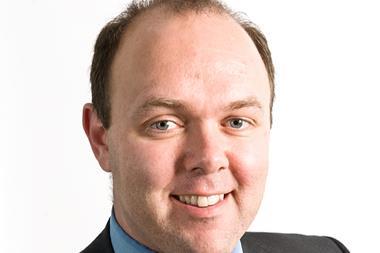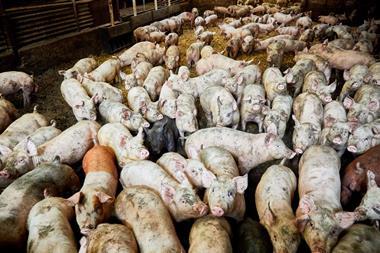After his last piece on equality, the EOC had a dig at Simon Howard, rather unfairly, as he sees it
Take a good look at this chap on the right here. Does this look like someone who “still sees men as breadwinners and women’s earnings as pin money” or who is “languishing in a time-warp”?
Well, that’s what Helen Wollaston, director of campaigns at the Equal Opportunities Commission, thinks.
I criticised the EOC (The Grocer, February 7, 2004) for not being particularly equal in its make-up (all three of the top posts are held by women, as are seven of the 11 posts of commissioner). I also ventured that the EOC’s interpretation of equality bore more resemblance to 1970s feminism than it did to the reality of the contemporary workplace.
What had particularly got my goat was the launch of the (still current) equal pay campaign which incites female employees to take their employers to task for being underpaid. I still think I could be forgiven for detecting a slight tinge of vengefulness in the campaign’s pay-off line - ‘It’s time to get even’.
It certainly sounds as if it’s intended to imply a level of come-uppance for someone - be it employers specifically or men more generally.
But not so, says Wollaston, writing on recruitment services website Ri5, which took up the story. “We deliberately chose a strong strapline for the campaign in order to grab people’s attention. But anyone reading any of our campaign materials would have discovered that our aim was to invite women to check their pay, and employers to check their pay systems, to ensure that they weren’t inadvertently short-changing female employees.”
Oh, so that’s alright, then. They intended to offend and provoke with headlines and posters, but if you got to read the materials in detail it was just about checking for inadvertent underpayment. Sounds like an ideal defence for those ads that drape scantily-clad nymphets over tyres and exhaust pipes - they’re just there to grab attention too.
OK, so let’s put the campaign to one side. How about the wider issue of the pay gap? I pointed out that in retail management, like should be compared with like, which Wollaston also picked up on. “Simon Howard raises some interesting points about the causes of women’s pay differentials…Why, in the retail sector, are women over-represented in smaller stores, with lower rates of pay?”.Well Helen, think about the average high street, and think about the number and size of women’s fashion stores - there are proportionately more of them and they are proportionately smaller. But it’s not only female fashion - male fashion, shoe shops, card shops, they all tend to attract a female workforce because typically they’re more interested in (say) fashion and accessories than they are in (say) cordless hammer drills and socket sets.
I know that’s a sexist generalisation, but it reflects the fact that men and women are different. But rather than worrying about female over-representation in smaller stores, how about male over-representation in larger ones?
Larger retail sites tend to be seven-day operations (supermarkets and large sheds) which require significant shift work and antisocial hours. All of that makes the rewards higher, but it also means a working mother finds it harder, and often decides not to return to this type of working environment after maternity leave - and short of demanding that single people cover all the antisocial shifts, no amount of legislation can ever provide an answer to women exercising that choice.
Apart from showing a lack of commercial understanding in the subject, the most worrying aspect of Wollaston’s riposte was that she ignored the issue of the unequal make-up of the EOC and its dogged pursuit of feminism - despite the fact men make as many complaints of discrimination as do women. Worse still, the EOC website features a campaign to promote construction careers to women, another to stop women being stereotyped, another about pregnancy in the workplace and, my bête noir, the campaign to ‘get even’. All women’s issues.
A few months ago I argued that we deserved an EOC which, itself, was more equal and more equal in its campaigns. And the best answer it could find was to blow a raspberry and accuse me of being a misogynist living in a time warp. All I can say to that Helen, babe, is “some misogynist, some time warp”.
n Simon Howard is a founder of Work Communications and writes the Jobfile column for the Sunday Times
Take a good look at this chap on the right here. Does this look like someone who “still sees men as breadwinners and women’s earnings as pin money” or who is “languishing in a time-warp”?
Well, that’s what Helen Wollaston, director of campaigns at the Equal Opportunities Commission, thinks.
I criticised the EOC (The Grocer, February 7, 2004) for not being particularly equal in its make-up (all three of the top posts are held by women, as are seven of the 11 posts of commissioner). I also ventured that the EOC’s interpretation of equality bore more resemblance to 1970s feminism than it did to the reality of the contemporary workplace.
What had particularly got my goat was the launch of the (still current) equal pay campaign which incites female employees to take their employers to task for being underpaid. I still think I could be forgiven for detecting a slight tinge of vengefulness in the campaign’s pay-off line - ‘It’s time to get even’.
It certainly sounds as if it’s intended to imply a level of come-uppance for someone - be it employers specifically or men more generally.
But not so, says Wollaston, writing on recruitment services website Ri5, which took up the story. “We deliberately chose a strong strapline for the campaign in order to grab people’s attention. But anyone reading any of our campaign materials would have discovered that our aim was to invite women to check their pay, and employers to check their pay systems, to ensure that they weren’t inadvertently short-changing female employees.”
Oh, so that’s alright, then. They intended to offend and provoke with headlines and posters, but if you got to read the materials in detail it was just about checking for inadvertent underpayment. Sounds like an ideal defence for those ads that drape scantily-clad nymphets over tyres and exhaust pipes - they’re just there to grab attention too.
OK, so let’s put the campaign to one side. How about the wider issue of the pay gap? I pointed out that in retail management, like should be compared with like, which Wollaston also picked up on. “Simon Howard raises some interesting points about the causes of women’s pay differentials…Why, in the retail sector, are women over-represented in smaller stores, with lower rates of pay?”.Well Helen, think about the average high street, and think about the number and size of women’s fashion stores - there are proportionately more of them and they are proportionately smaller. But it’s not only female fashion - male fashion, shoe shops, card shops, they all tend to attract a female workforce because typically they’re more interested in (say) fashion and accessories than they are in (say) cordless hammer drills and socket sets.
I know that’s a sexist generalisation, but it reflects the fact that men and women are different. But rather than worrying about female over-representation in smaller stores, how about male over-representation in larger ones?
Larger retail sites tend to be seven-day operations (supermarkets and large sheds) which require significant shift work and antisocial hours. All of that makes the rewards higher, but it also means a working mother finds it harder, and often decides not to return to this type of working environment after maternity leave - and short of demanding that single people cover all the antisocial shifts, no amount of legislation can ever provide an answer to women exercising that choice.
Apart from showing a lack of commercial understanding in the subject, the most worrying aspect of Wollaston’s riposte was that she ignored the issue of the unequal make-up of the EOC and its dogged pursuit of feminism - despite the fact men make as many complaints of discrimination as do women. Worse still, the EOC website features a campaign to promote construction careers to women, another to stop women being stereotyped, another about pregnancy in the workplace and, my bête noir, the campaign to ‘get even’. All women’s issues.
A few months ago I argued that we deserved an EOC which, itself, was more equal and more equal in its campaigns. And the best answer it could find was to blow a raspberry and accuse me of being a misogynist living in a time warp. All I can say to that Helen, babe, is “some misogynist, some time warp”.














No comments yet